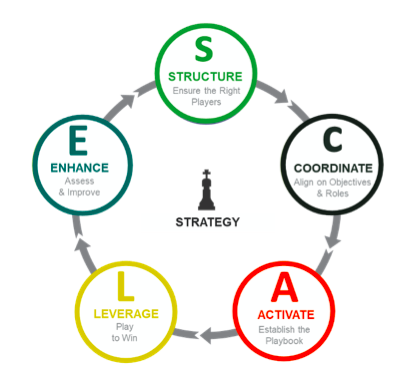Introduction of the S.C.A.L.E.© Team Performance Model
High Performing Leadership Teams are able to SCALE their performance to drive business results.
In the current environment, senior teams are challenged even more to work well with one another and ensure that their organizations can handle volatility and uncertainty. Many CEOs struggle with how to raise the level of the executive team’s performance on a sustainable basis. The ability to execute strategically and deliver on expected financial performance outcomes is paramount. Perhaps even more important is the team’s ability to scale and grow.
Various team maturity models have been introduced over the years that speak to the evolutions of teams. In our work with top-tier teams, we have refined the approach to helping senior teams create high performance together and accelerate the growth of their organizations. At the core of our team model is a clear and understood Strategy, the most critical element for C-suite teams to align with to be effective.
We have found that there are five specific phases to the performance of these teams driving the strategy that enables them to perform and scale as the company grows; thus, our model acronym helps us to describe these five phases.
Structure– in the first phase, teams must be sure that they have the right players on the team. Do you have the right team members with the right skills and the right attitudes in the right roles? Do you have a reason to exist as a team, other than just an organization reporting structure? Are you aligned with the strategy for growth?
Coordinate– You need to confirm the understanding of the business strategy across the team and then focus on shaping the team priorities and how they relate and support the business strategy. Using Summit’s proprietary Executive Team Diagnostic, we see on average that 60% of executives buy into their company’s strategy, but only 33% believe they are aligned on how to execute it. Once the direction and priorities are clear, the team needs to work on ensuring that they have a clear operating model. In other words, are they clear on the alignment of deliverables, operating protocols, and each member’s role and responsibility within the context of the plan?
Activate– To unlock the potential in the team and discover synergies, members must agree on how to work together as a team. This means that they have designed the best communication channels, determined the culture of the team, and ultimately increased the trust. Our research shows that high trust in teams is the catalyst to creating flow and reducing dissonance while fostering candor. Ultimately this leads to better decision making, innovation, and performance.
Leverage– Once the teams are running the business, interacting with each othering regularly and mobilizing the organization around the growth agenda, they must find a way to sustain what they have over time. They should regularly provide peer feedback and hold each other accountable. Our research shows average management teams expect the CEO to hold the team accountable. However, the highest performing teams can hold each other accountable at the peer group level. Productive conflict is essential to growth, yet only 15% of executive teams surveyed say that conflict is addressed in an open and direct manner within their teams.
Enhance– In many ways, what we choose to measure and track shapes what we do as people and as a team. In the enhance phase, members set up how they will continuously measure the team’s contribution to the business strategy based on their agreements from the prior phases. To remain agile, adapting to the needs of the business, and sustain momentum, teams should consistently check themselves against the critical outcomes that focus on results and behaviors and adjust accordingly. In our proprietary assessment, the lowest rating is usually the team’s assessment of how well they are working together, and this requires continuous maintenance.
Teams do not move through the SCALE.© performance model phases one time; instead, it is a continuous cycle. Every time there is a change in strategy, members, structure, or goals, the team needs to do a check-up on their agreements, measures, and behaviors towards one another. The good news is that as teams are aligned and skilled within these five phases, they can move through them more quickly and enhance their performance with each evolution. In addition, as members join or leave, the management team does not miss a beat.
